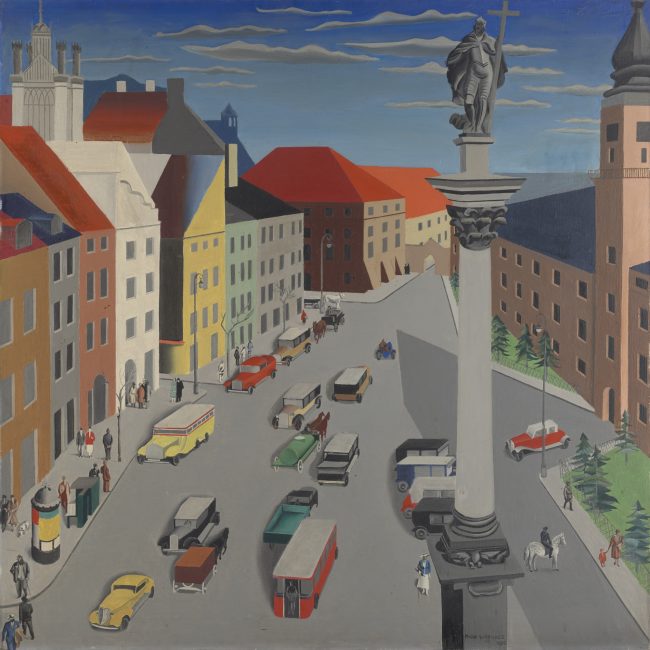
„Plac Zamkowy” (Castle Square)
Maria Ewa Łunkiewicz-Rogoyska (1895–1967) was a member of both Polish and international avant-garde. For many years, she was a friend and collaborator of the Constructivist painter Henryk Stażewski (1894–1988), among other figures. The artist’s paintings from the 1930s reveal the influence of Purism and Cubism, which she regarded as a new academy of form, akin to the art of ancient Greece. The oeuvre of the painter who strove to blaze her own artistic trail bears testimony to a growing prominence of women in Polish art of the inter-war period. The painting was purchased by the Museum from the artist in 1962. It had never been exhibited or published in reproductions before.
Presented to the public for the first time, the painting formed part of the Museum’s main exhibition in 1974. The work featured in two exhibitions that took Warsaw as their theme in Belgrade (1976) and Ferrara (1987). It belongs to a range of sixty works by the painter that survived World War II owing to the fact that they were removed from the city in 1942. The other works burnt down in the artist’s apartment during the Warsaw Uprising of 1944, organised by conspiratorial armed forces (Home Army) against the German occupier. The painting was not a commissioned work; it is one of several views of Warsaw that the artist painted in the 1930s beside landscapes, still lives and figural scenes.
A fragment of Castle Square is shown here from the direction of Krakowskie Przedmieście Street. The artist abandoned traditional conventions of realism and tapped into a modern artistic language, characterised by simplified forms subjected to the rigour of geometrical order. A great number of cars does not reflect the real vehicle traffic in the square, but rather the painter’s passion for automobiles, which stood for her as a symbol of modernity. The view is depicted from the height of the statue of Sigismund III Vasa (1566–1632, King of Poland (1587–1532) on the column.
Such an extraordinary perspective of the square was probably inspired by a photograph by the famous Warsaw photographer Henryk Poddębski (1890–1945) from 1917. The elevated point of view highlights the shape of the square, akin to an irregular triangle. The escaping perspective is underscored by the eye-catching red patches of burgher house roofs on the axis of the composition. Visible on the left are the Old Town burgher houses and the Neo-Gothic
top of the facade of the Archcathedral Basilica of the Martyrdom of St. John the Baptist; on the right – the Royal Castle with the Clock Tower.
The square was delineated between 1818 and 1821 as a result of the demolition of the Krakowska Gate and sections of the city walls. The main accent is the Sigismund III Vasa Column – the oldest secular monument in Poland – erected in 1644. Although the city centre shifted towards Marszałkowska Street and Jerozolimskie Avenues, between the two World Wars (1918–1939) the square continued to function as a major spot in Warsaw, owing to the Castle, which in 1926 became the seat of the President of the Second Republic of Poland, which came into being after the country regained independence in 1918.
Plac Zamkowy (Castle Square)
MARIA EWA ŁUNKIEWICZ-ROGOYSKA
WARSAW; 1935
OIL ON CANVAS
MHW 2995
90,5 × 90,5 CM
Image licensed under: ![]()
